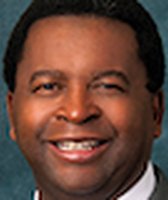Stand up for the facts!
Our only agenda is to publish the truth so you can be an informed participant in democracy.
We need your help.
I would like to contribute
Republican House Speaker Richard Corcoran and Democratic mayor Andrew Gillum turned a Twitter clash about one of Florida’s most divisive issues into a one-on-one debate.
The pair’s Feb. 13 showdown on sanctuary cities came less than two weeks after Corcoran’s political committee released a TV ad that promotes HB 9, which would ban sanctuary cities in the state of Florida. Gillum, who unlike Corcoran is officially in the 2018 governor’s race, called the depiction of a young white woman shot by a hooded man on a suburban street "vile" and race-baiting.
Over 45 minutes in the state capital, Corcoran reinforced his position with emotional anecdotes of young women killed during run-ins with undocumented immigrants, for which he faulted sanctuary city policy. Gillum, on the other hand, accused Corcoran of trying to turn Florida into a "show-me-your-papers" police state.
Claims about sanctuary cities are often not as cut-and-dried as they sound. Here, we’ll break down the accuracy of key claims from the debate with context.
Gillum: "Immigrant communities are far less likely to commit crimes than those who are native-born."
Sign up for PolitiFact texts
Gillum accurately cited the findings of the libertarian Cato Institute in a research and policy brief to discredit the stereotype that undocumented immigrants are violent.
"The Cato Institute, which is not a bastion of the left, a pretty conservative research institute, found that immigrant communities are far less likely to commit crimes than native born," Gillum said. "That, again, is a conservative study."
The March 2017 study found that "illegal immigrants are 44 percent less likely to be incarcerated than natives. Legal immigrants are 69 percent less likely to be incarcerated than natives. Legal and illegal immigrants are underrepresented in the incarcerated population while natives are overrepresented."
There is no national database or study tracking how many people have been killed by undocumented immigrants or the nationality of the victims, but numerous studies have found that immigrants are not more likely to commit crimes than U.S.-born citizens.
Corcoran: (Illegal immigrants) "have a due process substantive right on whether or not they’re an illegal immigrant. That’s it. They have no other rights. They’re illegal."
As we’ve concluded in the past about a similar claim, it’s not entirely accurate to say immigrants have no rights due to their undocumented status.
Undocumented immigrants have many constitutional rights, such as freedom of speech and religion. Furthermore, experts said that the Fifth Amendment, as well as the Fourteenth Amendment, protects everyone from deprivation of life, liberty or property without due process of law.
In one Supreme Court case — Zadvydas vs. Davis (2001) — justices ruled that "once an alien enters the country, the legal circumstance changes, for the due process clause applies to all persons within the United States."
Still, immigrants in the country without permission don’t share all of the constitutional rights of citizens. For example, some undocumented immigrants in removal proceedings have not gotten due process in court, and they don’t have a right to a government-paid lawyer in immigration court.
Corcoran: "There’s nothing in (HB 9) about teachers"
Gillum and Corcoran traded barbs about the implications of HB 9, with Gillum saying the legislation "potentially creates ICE agents out of our school teachers and professors. It creates ICE agents out of governmental officials; out of law enforcement officials, who primary job is to keep their community safe."
As Corcoran said, that’s not literally true.
HB 9 does not explicitly mention making teachers and professors ICE agents, but the bill would require state entities, local governmental entities, and law enforcement agencies to comply with and support the enforcement of federal immigration law or risk getting penalized.
"It doesn’t make ICE agents out of any of the people you listed,"Corcoran said. "The whole point of the bill is to end criminal, illegal immigrants being on our streets and to force all of the elected officials to follow the law and corporate with the federal law."
Gillum: "The speaker himself is an immigrant. He spent the early years of his life in Canada."
Gillum’s comment echoes the opening of a critical Miami Herald column about the TV ad from Corcoran’s political committee. While columnist Fabiola Santiago did not literally call Corcoran an immigrant, she did point out his reluctance to acknowledge his Canadian roots, noting he usually opens his biography at age 11 in Pasco County, Florida.
Corcoran did not care for Gillum’s label, to say the least.
"I'm not an immigrant. I'm a natural-born American citizen," replied Corcoran. "To say I'm an immigrant is you playing politics and using pejoratives in the worst possible way."
He said he was in Toronto, Canada, while his American-born father worked for the U.S. government.
Corcoran said his mother was an immigrant who gained legal status after she married his father.
A closer look at victims mentioned by Corcoran
Corcoran invoked the names of four young women who died as a result of run-ins with men in the country illegally, including the well-known death of Kate Steinle in San Francisco. But his characterizations exaggerated important details.
Corcoran claimed Steinle was "savagely killed by a bullet from an illegal criminal." The jury in the case decided that Jose Ines Garcia Zarate, a 45-year-old homeless undocumented immigrant, did not willfully kill Steinle; the shooting was an accident.
The jury acquitted him of murder and manslaughter charges, but found him guilty of being a felon with a firearm.
Corcoran also brought up the deaths of two Virginia Beach teenagers — Tessa Tranchant and Allison Kunhardt — who were fatally hit by a drunk driver named Alfredo Ramos, an undocumented Mexican immigrant.
"All of a sudden their car is obliterated, completely destroyed, by an illegal immigrant, on the streets because it was a sanctuary city, let out," he said.
However, no city in Virginia has declared itself a sanctuary city, according to the Washington Post. A Virginian-Pilot report said a state law requires local law enforcement to contact immigration authorities when they have an illegal immigrant in custody.
Ramos had a blood alcohol content of .24 at the time of the crash. Virginia’s legal blood alcohol limit is .08, making Ramos three times over the limit. Before the crash and conviction, he had three prior criminal convictions, some of which related to alcohol. Ramos was sentenced to 24 years in prison and then deportation.
The fourth woman Corcoran mentioned was Sarah Root, a 21-year-old recent college graduate who also died in a car accident. Edwin (or Eswin) Mejia, a Honduran undocumented immigrant, was drunkenly street racing in Omaha, Neb., and hit Root.
Mejia was temporarily released from jail, but did not return for a drug test when he should have. He is still wanted by ICE.
Corcoran said Mejia was let out under a sanctuary policy, but Omaha is not a sanctuary city.
Other circumstances led to Mejia being released. The judge didn't know Mejia had failed to appear for two earlier court hearings, making him a flight risk, according to the Washington Post. Omaha police also reached out to ICE to ask for a detainer, which would have kept Mejia for another 48 hours, but the federal agency declined, according to the Des Moines Register.
Our Sources
See hyperlinks in story.























